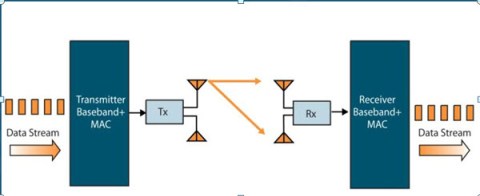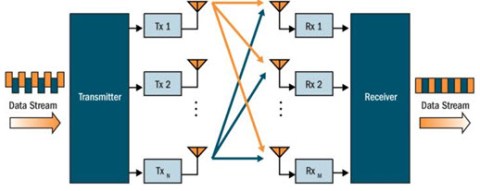How Stuff Works – 802.11n and Spatial Multiplexing
This is the third post in my “How Stuff Works” series. The first two posting discussed MIMO and channel bonding. This post looks at another technical improvement that leads to greater speed in 802.11n networks – spatial multiplexing.
It is helpful to take a quick look at a classic 802.11 transmitter.
In this scenario, only one data stream is sent from the transmitter to the receiver (represented by the orange line).
With spatial multiplexing, multiple data streams are transmitted at the same time. They are transmitted on the same channel, but by different antenna. They are recombined at the receiver using MIMO signal processing. This is represented in the diagram above with two spatial streams – an orange colored one and a navy blue colored one.
Spatial multiplexing doubles, triples, or quadruples the data rate depending on the number of transmit antennas. Remember, you may hear three numbers when referring to 802.11n or MIMO networks – the first is the number of transmit antenna, the second is the number of receive antenna, and the third is the number of spatial streams. For example, a 3×3x2 system has two spatial streams.



![[LinkedIn]](https://i0.wp.com/farm4.static.flickr.com/3477/3463037125_247575d1f3_m.jpg)
![[LinkedIn]](https://i0.wp.com/farm4.static.flickr.com/3598/3463037145_924738ec38_m.jpg)
great article sir
When I was looking for information on how does MIMO improves the capacity. this one gives me clear picture. Simple and Good.
-Deena
i am doing a presentation on spacial multiplexing in my class this article help me understand it better thank you
Really great.
very successful
A crystal clear explaination of spatial multiplexing!
Hi Douglas,
I have just a doubt. In the “spatial multiplexing” configuration, I didn’t figure if every single rx antenna can receive both streams simultaneously, or only one at time.
Greeting from Italy
what is recursive spatial multiplexing
it gives me clear knowledge about spetial multiplexing…
it was a nice articles, thanks for sharing,
is MRC and spatial multiplexing same ?
I’m just curious: why would such thing as a 3x3x2 exist? I mean: if both the transmitter and the receiver have 3 antennas, why would they only use 2 spatial streams, and not the maximum of 3 spatial streams allowed by such configuration? Thanks to anyone willing to answer!
Supporting more spatial streams involves more than just the number of Tx and Rx antenna. It increases, significantly, the complexity of the baseband processing. Having the extra TX and RX antenna still provide for antenna diversity, which is important to improving the 2 streams SNR and thus data rates at range.
Pity that nobody explains (in a simple way) how a spatial stream work, i.e. how is collision and interference avoided with spatial streams.
Why is there no interference when multiple signals are transmitting on multiple antennae on the same channel?
I too am perplexed by the idea of, say, 2 spatial streams both essentially combined as they’re flying across on the same frequency channel–how do the receivers pick out the 2 spatial streams when they’re all on the same frequency channel? It’s as if 2 flashlights of exactly the same light color are pointed at your 2 eyes, and how would your brain figure out which flashlight did photons come from? Can someone please explain?
This article:
http://trends-in-telecoms.blogspot.com/2011/05/multi-antenna-systems-mimo-how-spatial.html
gives a bit more detail on how the different antennas encode different data streams as linearly independent combinations of the data streams.
The article tries but ultimately fails as well for me. For instance the author says, “If all the beams can be kept orthogonal to each other, there is no interference between the data streams; in other words, we have established parallel channels.” And just exactly how are 2 beams between my access point and my laptop kept orthogonal relative to each other? Furthermore, the author mentions a caveat at the end, “But it is also very important to notice that the number of IOs poses an upper limit: if two data streams are transmitted to the same IO, then the RX has no possibility of sorting them out by forming different beams.” Which still leaves me not understanding how multiple spatial streaming is actually accomplished without resulting in incoherence at the receiving end.
I’m reading this PDF–still am only halfway through it–to be found as http://dspace.kaist.ac.kr/bitstream/10203/22921/1/04407232.pdf. Its problem domain is cell phone systems, but the concepts are applicable to WiFi as well I would think. This is the first article I’ve seen that doesn’t just gloss over problems of spatial multi streaming in actual practice, but actually discusses it in fair detail that is understandable to anyone fairly technical. The authors clearly understand what they are talking about, and they don’t simply bandy terms around but actually explain them a bit.
There is something not clear…what are the “spaces” in Data Stream in classic transmitter? Where do they come from?